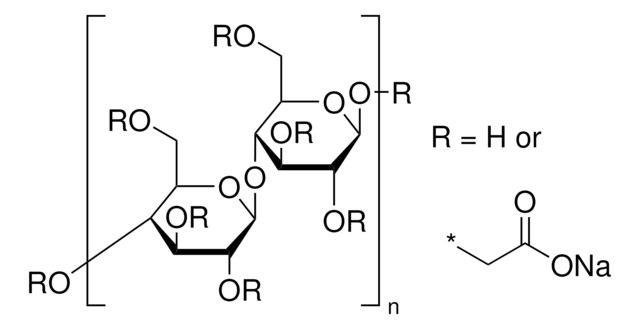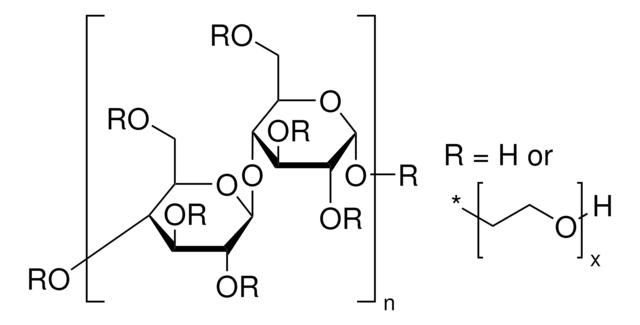419338
Sodium carboxymethyl cellulose
average Mw ~700,000
Sinônimo(s):
Carboxymethylcellulose sodium salt
Faça loginpara ver os preços organizacionais e de contrato
About This Item
Produtos recomendados
forma
powder
Nível de qualidade
temperatura de autoignição
698 °F
peso molecular
average Mw ~700,000
Extensão da rotulagem
0.9 carboxymethyl groups per anhydroglucose unit
pf
270 °C (dec.)
InChI
1S/C6H12O6.C2H4O2.Na/c7-1-3(9)5(11)6(12)4(10)2-8;1-2(3)4;/h1,3-6,8-12H,2H2;1H3,(H,3,4);
chave InChI
DPXJVFZANSGRMM-UHFFFAOYSA-N
Procurando produtos similares? Visita Guia de comparação de produtos
Descrição geral
Sodium carboxymethyl cellulose (CMC) is a water dispersible sodium salt of carboxy-methyl ether of cellulose that forms a clear colloidal solution. It is a hygroscopic material that has the ability to absorb more than 50% of water at high humidity. It is also a natural polymeric derivative that can be used in detergents, food and textile industries.
Aplicação
CMC can be used as a binder in the preparation of graphene nano-platelet based inks for the fabrication of dye sensitized solar cells (DSSCs). It can also be used as a viscosity enhancer in the development of tyrosinase based inks for the formation of electrodes for biosensor applications. CMC is used as a support material for a variety of cathodes and anodes for microbial fuel cells.
Código de classe de armazenamento
11 - Combustible Solids
Classe de risco de água (WGK)
WGK 1
Ponto de fulgor (°F)
Not applicable
Ponto de fulgor (°C)
Not applicable
Equipamento de proteção individual
Eyeshields, Gloves, type N95 (US)
Escolha uma das versões mais recentes:
Já possui este produto?
Encontre a documentação dos produtos que você adquiriu recentemente na biblioteca de documentos.
Os clientes também visualizaram
Amélie Béduer et al.
Advanced healthcare materials, 4(2), 301-312 (2014-09-03)
Millimeter to centimeter-sized injectable neural scaffolds based on macroporous cryogels are presented. The polymer-scaffolds are made from alginate and carboxymethyl-cellulose by a novel simple one-pot cryosynthesis. They allow surgical sterility by means of autoclaving, and present native laminin as an
Tian Carey et al.
Nature communications, 8(1), 1202-1202 (2017-11-02)
Fully printed wearable electronics based on two-dimensional (2D) material heterojunction structures also known as heterostructures, such as field-effect transistors, require robust and reproducible printed multi-layer stacks consisting of active channel, dielectric and conductive contact layers. Solution processing of graphite and other
Radiation preparation and swelling behavior of sodium carboxymethyl cellulose hydrogels
Liu P, et al.
Radiation Physics and Chemistry, 63(3-6), 525-528 (2002)
Heleen M de Vogel-van den Bosch et al.
BMC genomics, 9, 231-231 (2008-05-21)
The selective absorption of nutrients and other food constituents in the small intestine is mediated by a group of transport proteins and metabolic enzymes, often collectively called 'intestinal barrier proteins'. An important receptor that mediates the effects of dietary lipids
Richard P G Ten Broek et al.
Lancet (London, England), 383(9911), 48-59 (2013-10-01)
Formation of adhesions after peritoneal surgery results in high morbidity. Barriers to prevent adhesion are seldom applied, despite their ability to reduce the severity of adhesion formation. We evaluated the benefits and harms of four adhesion barriers that have been
Nossa equipe de cientistas tem experiência em todas as áreas de pesquisa, incluindo Life Sciences, ciência de materiais, síntese química, cromatografia, química analítica e muitas outras.
Entre em contato com a assistência técnica
![Poly[(o-cresyl glycidyl ether)-co-formaldehyde] average Mn ~870](/deepweb/assets/sigmaaldrich/product/structures/492/686/3e332037-f67b-49a2-8326-268fc7b0b900/640/3e332037-f67b-49a2-8326-268fc7b0b900.png)


